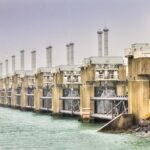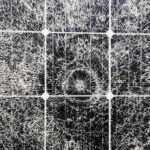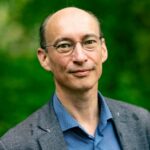Download het Nederlandse persbericht rondom dit artikel
There is an English saying that you have “lies, damned lies and statistics”. Here, I would like to introduce a variation on this expression: “There are lies, damned lies, statistics … and sloppy science”.
This morning, there was lot of noise in the Dutch media (unfortunately in Dutch only) about new research that was claiming a dramatic warming of 4 degrees in 2050. The news report quoted Dutch econometricians from the University of Tilburg. They had done a statistical analysis of temperature data and the influence of CO2 and solar radiation and concluded that aerosols masked much more of the warming of greenhouse gases than previously thought. This also means there is more warming in the pipeline for the future if the trend of global brightening, that has been detected by researcher Martin Wild of ETH in Zürich, will continue in the coming decades. They also draw policy conclusions from their research stating that in order to avoid more than 2 degree warming more drastic measures are to be taken. This news was copied by many Dutch news outlets.
Detection
Although at first I could not figure out if there was a paper behind the news article and whether or not it has been accepted for publication (I still don’t know), I finally determined it had to be this paper: http://center.uvt.nl/staff/magnus/wip04.pdf
I decided to pass the paper on to Ross McKitrick, who, as many of the readers know, published two interesting papers (here and here) on the influence of different economic parameters on the pattern of warming at the surface. Within hours McKitrick came back with an interesting finding which makes any detailed discussion on the paper let’s say… irrelevant.
Remember, their study is an attribution study depending on long term trends in temperature measurements. For their study they use a rather obscure CRU dataset: CRU TS 2.1. You can find its documentation below. The webpage reads:
The CRU TS 2.1 data-set comprises 1224 monthly grids of observed climate, for the period 1901-2002, and covering the global land surface at 0.5 degree resolution. There are nine climate variables available: daily mean, minimum and maximum temperature, diurnal temperature range, precipitation, wet day frequency, frost day frequency, vapour pressure and cloud cover.
Read the documentation
There is also a peer-reviewed paper behind CRU TS 2.1: Mitchell and Jones, International Journal of Climatology, 2005, so that’s OK. However, if the authors had just cared to go through this webpage in some detail, they would have found a link to this page:
It says:
Q1. Is it legitimate to use CRU TS 2.0 to ‘detect anthropogenic climate change’ (IPCC language)?
A1. No.
CRU TS 2.0 is specifically NOT designed for climate change detection or attribution in the classic IPCC sense. The classic IPCC detection issue deals with the distinctly anthropogenic climate changes we are already experiencing. Therefore it is necessary, for IPCC detection to work, to remove all influences of urban development or land use change on the station data.
In contrast, the primary purpose for which CRU TS 2.0 has been constructed is to permit environmental modellers to incorporate into their models as accurate a representation as possible of month-to-month climate variations, as experienced in the recent past. Therefore influences from urban development or land use change remain an integral part of the data-set. We emphasise that we use all available climate data.
If you want to examine the detection of anthropogenic climate change, we recommend that you use the Jones temperature data-set. This is on a coarser (5 degree) grid, but it is optimised for the reliable detection of anthropogenic trends. For precipitation trends, use the Hulme data-set (5 degree grid or 2.5 x 3.75 grid). There are few alternatives to Hulme in the first half of the 20th century; later, to include the oceans use the Xie and Arkin data-set; for the last 25 years you could also use the GPCC data-set.
Yikes. This dataset is not to be used for the type of study performed by these econometricians. Never. Period. Don’t use it. Lies, damned lies, statistics and very sloppy science.






Dát zal de kranten wel weer niet halen..
Deze wel:
http://www.telegraaf.nl/binnenland/6245436/__VROM…
Haha, ze hebben dus de "unadjusted" data gebruikt ipv de adjusted. Maar dat willen de skeptici toch graag? ;) Ik vraag me sowieso af waarom econometristen een klimaatanalyse doen… atmosferische (klimaat) fysici gaan toch ook geen economisch onderzoek doen? Als ze wat literatuur hadden gelezen hadden ze zich waarschijnlijk wel achter hun oren gekrabt, want zelfs voor 2100 zijn er maar weinig alarmistische studies die een opwarming van 4 graden (C) laten zien.
Nee, sceptici willen niet dat alleen unadjusted data wordt gebruikt, want dan zou het urban heat island effect er volledig in mee zijn genomen. Wel willen sceptici dat alle gegevens toegankelijk zijn, unadjusted en adjusted en vooral hoe die gegevens bewerkt zijn.
En per meetstation de gegevens van het onderhoudslogboek waar onder andere de veranderingen in meethoogte, de verplaatsingen, de uitkomsten van periodieke ijkingen en de vrije ruimte rond het meetstation worden beschreven. :-)
@Fred: het gaat er niet om wat sceptici willen of niet willen of wat alarmisten willen of niet willen. Het gaat erom dat wetenschappelijke studies de toets der kritiek moeten kunnen doorstaan. En als je dus puur een verband tussen CO2, zon en temperatuur onderzoekt moet je dus gebruik maken van een dataset waaruit andere verstorende factoren zijn uitgefilterd (UHI, landgebruik etc.)… en verder moet je dan niet dingen weglaten die je simpelweg niet weg kunt laten zoals oceanen en wolken. Gewoon wetenschappelijke FC Knudde dus!
Ik heb meer het idee dat uw kennis van klimaatwetenschap nogal FC knudde is. Dat blijkt ook nogal uit de vele onzinnige kritiek die hier bijvoorbeeld geuit wordt op de temperatuurmetingen wereldwijd (satelliet en surface observations). Leg de metingen van beide gewoon eens over elkaar (pas de baselines aan), en kijk er eens objectief naar. Die passen vrijwel perfect op elkaar (zeker de trends op lagere termijn, en zeker nu UAH ook eindelijk een correctie heeft uitgevoerd die de abnormale schommelingen tegengaat (www.drroyspencer.com)), dus er is geen sprake van "cooking the books" in de surface stations of van een grote globale UHI bias, de laatste 30 jaar.
Dat de hydrologische cyclus (wolken) en in mindere mate de oceanen weggelaten worden is complete BS, veel processen zijn echter wel relatief slecht begrepen, en leiden dus tot onzekerheden. Zo zijn er nog wel meer processen relatief slecht begrepen en onzeker, maar blijft het erg onwaarschijnlijk dat deze AGW significant tegenwerken. We hebben dus nog wat te doen de komende tijd.
Bij het doen van metingen en bij het beoefenen van (klimaat)wetenschap behoeven niet noodzakelijkerwijs dezelfde vaardigheden een rol te spelen.
Wel is het aangenaam als in beide gevallen met een kritische blik gekeken wordt naar de resultaten.
Als het KNMI een correctie van 0,1K moet aanbrengen omdat er een paar bomen en/of struiken verrassend spontaan zijn blijven groeien, kan men zich afvragen of weerkundigen of klimatologen wel eens naar buiten kijken.
Een in alle opzichten juist gemeten temperatuur is toch wat anders dan een temperatuur die verkregen wordt door allerlei statistische handigheidjes.
Ook lezenswaard:
http://wattsupwiththat.com/2010/03/09/accuracy-of…
Bekijk de omgeving van een aantal meetstations in de VS:
http://gallery.surfacestations.org/main.php?g2_vi…
wat denk je?
Econometrie heeft ook het geldpotje zien staan..
Climate Wars
http://factsnotfantasy.blogspot.com/2010/03/clima…
Sorry guys,
Elke wetenschapper, peer reviewed of niet die mij verteld wat de de gemiddelde temperatuur zal zijn in 2050 hoort in een psychatrische inrichting te worden opgenomen.
Dit is geen serieuze discussie waard.
Dit is P R O P A G A N D A.
Mag ik in aansluiting op de opmerkingen van Arjan eens een gekke vraag stellen. Ik ben niet zo thuis in de academische wereld dus vraag ik me af hoe zoiets gaat. Aan de aanwezigheid van dit trio op de uvt is naar ik aanneem zoiets als een functieomschrijving gekoppeld. Wie daar behoefte aan heeft kan nagaan waarvoor deze wetenschappers betaald worden. Ook kan de onderhavige werknemer maandagochtend nog even nalezen wat hij daar ook al weer kwam doen. Mijn vraag is: Past het bastelen van eenvoudige klimaatmodellen binnen de functie??
Voor de gewone burger is het natuurlijk een zegen dat er mensen zijn als Marcel, die de weg weten. Ik was alweer begonnen met het vullen van de zandzakken.
Het lijkt me tot besluit wel gepast hier te eindigen met een citaat van de grote roerganger uit Os: “Effe dimme” daar in Tilburg!
"Ook kan de onderhavige werknemer maandagochtend nog even nalezen wat hij daar ook al weer kwam doen"
Antwoord:
Geld verdiennuhhhh !
Klimaat is een blanco checque, dus welke niet gepensioneerde, niet zelfstandige, zou dit niet doen?
Wageningen, andere "universiteiten", Alterra, Sense, TNO, ECN, KNMI, en dat instituut in zeist: alle zijn ze op zoek naar, en kruipen in, dezelfde hoorn des overvloeds.
http://www.climategate.nl in het nieuws:
http://www.telegraaf.nl/binnenland/6250662/___Kli…
Op je wenken bedient!
http://wattsupwiththat.com/2010/03/09/wrong-way-e…
De universiteit in Tilburg heette in de 70er jaren de Katholieke Hogeschool Tilburg KHT. De hogeschool werd een universiteit en om begrijpelijke redenen werd de naam gewijzigd in KUB (Katholieke Universiteit Brabant)
Nu heet ze de UvT Universiteit van Tilburg.
Blijkbaar wordt het er niet beter op en bij deze studie past beter de naam Katholieke Universiteit Tilburg.
Ik hoop dat de economische modellen beter kloppen.
zelfs bij de groene ruimte , prominent
http://www.groeneruimte.nl/nieuws/artikel.html?id…